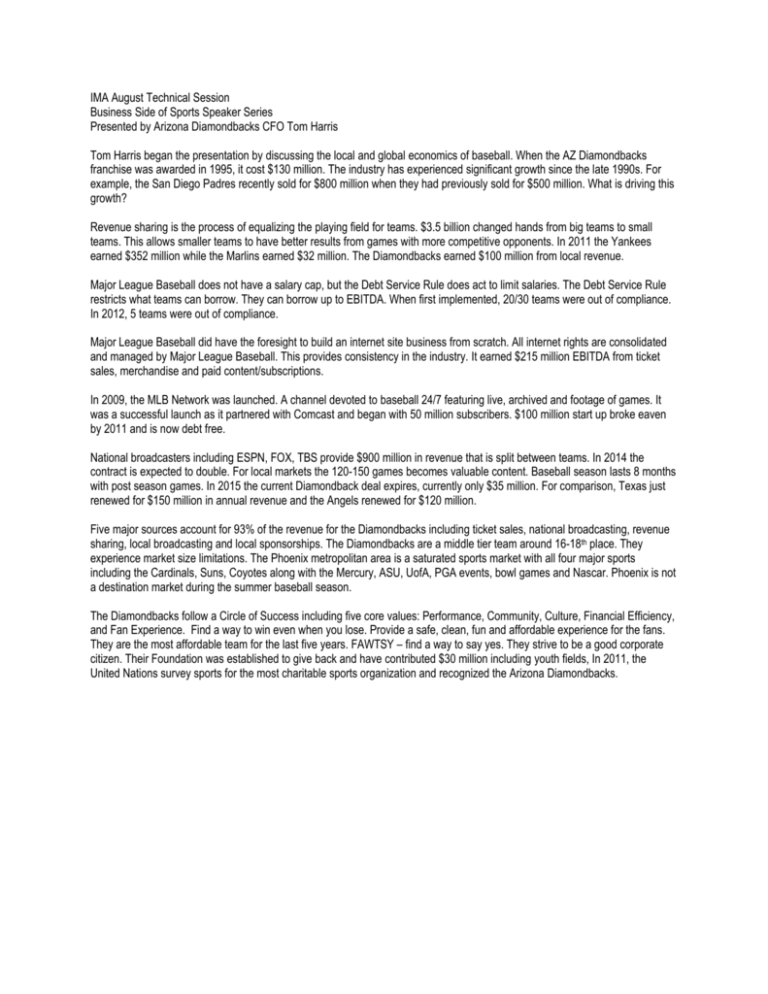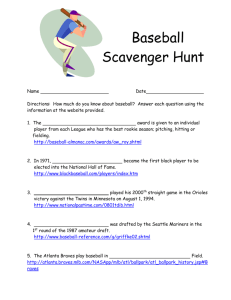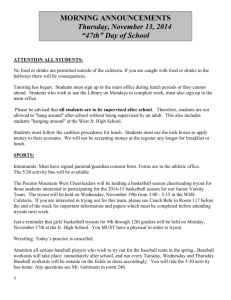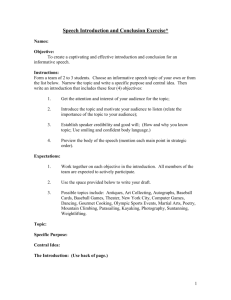IMA August Technical Session Business Side of Sports Speaker
advertisement

IMA August Technical Session Business Side of Sports Speaker Series Presented by Arizona Diamondbacks CFO Tom Harris Tom Harris began the presentation by discussing the local and global economics of baseball. When the AZ Diamondbacks franchise was awarded in 1995, it cost $130 million. The industry has experienced significant growth since the late 1990s. For example, the San Diego Padres recently sold for $800 million when they had previously sold for $500 million. What is driving this growth? Revenue sharing is the process of equalizing the playing field for teams. $3.5 billion changed hands from big teams to small teams. This allows smaller teams to have better results from games with more competitive opponents. In 2011 the Yankees earned $352 million while the Marlins earned $32 million. The Diamondbacks earned $100 million from local revenue. Major League Baseball does not have a salary cap, but the Debt Service Rule does act to limit salaries. The Debt Service Rule restricts what teams can borrow. They can borrow up to EBITDA. When first implemented, 20/30 teams were out of compliance. In 2012, 5 teams were out of compliance. Major League Baseball did have the foresight to build an internet site business from scratch. All internet rights are consolidated and managed by Major League Baseball. This provides consistency in the industry. It earned $215 million EBITDA from ticket sales, merchandise and paid content/subscriptions. In 2009, the MLB Network was launched. A channel devoted to baseball 24/7 featuring live, archived and footage of games. It was a successful launch as it partnered with Comcast and began with 50 million subscribers. $100 million start up broke eaven by 2011 and is now debt free. National broadcasters including ESPN, FOX, TBS provide $900 million in revenue that is split between teams. In 2014 the contract is expected to double. For local markets the 120-150 games becomes valuable content. Baseball season lasts 8 months with post season games. In 2015 the current Diamondback deal expires, currently only $35 million. For comparison, Texas just renewed for $150 million in annual revenue and the Angels renewed for $120 million. Five major sources account for 93% of the revenue for the Diamondbacks including ticket sales, national broadcasting, revenue sharing, local broadcasting and local sponsorships. The Diamondbacks are a middle tier team around 16-18th place. They experience market size limitations. The Phoenix metropolitan area is a saturated sports market with all four major sports including the Cardinals, Suns, Coyotes along with the Mercury, ASU, UofA, PGA events, bowl games and Nascar. Phoenix is not a destination market during the summer baseball season. The Diamondbacks follow a Circle of Success including five core values: Performance, Community, Culture, Financial Efficiency, and Fan Experience. Find a way to win even when you lose. Provide a safe, clean, fun and affordable experience for the fans. They are the most affordable team for the last five years. FAWTSY – find a way to say yes. They strive to be a good corporate citizen. Their Foundation was established to give back and have contributed $30 million including youth fields, In 2011, the United Nations survey sports for the most charitable sports organization and recognized the Arizona Diamondbacks.






